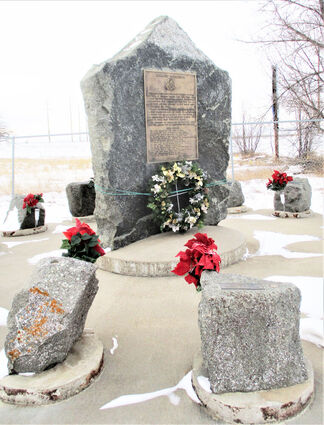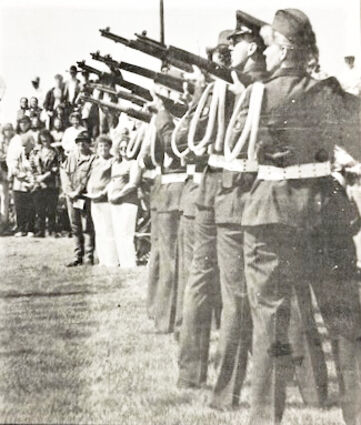Former squadron commander revisited the Airmen's Memorial in Harlem
December 29, 2021

In this recent photo the Airmen's Memorial at Harlem is shown decorated for Christmas. The Memorial was first considered during the operations to recover 13 Air Force crewmembers killed when two cargo transports collided about nine miles north of Harlem in November, 1992. Built by donated labor and materials, the Memorial is decorated for certain days by a committee of local volunteers.
Darwin Zellmer, of Harlem, recently shared a letter from William McKinney, Col. USAF (Ret). McKinney, and his wife, Jill, visited the Airmen's Memorial in Harlem last fall on the way from their home in Florida to Glacier Park. Part of the trip was to fulfill a promise the retired colonel made to his wife to let her see and experience the memorial to the 13 Air Force crew members who died in an air crash north of Harlem.
McKinney was the squadron commander of 11 of the 13 crewmembers killed when two C-141 cargo jets collided and crashed on the night of November 30, 1992 during a training exercise. The accident happened as one of the planes was pulling away from the flying tanker after being refueled in flight. Many area Harlem-area residents were pulled in to the tragedy both as volunteers in the recovery effort as well as hosts for visiting officials investigating the crash for an extended period.
Darwin, along with Rod Becker, is co-chair of the committee that has maintained the Airmen's Memorial on the south edge of Harlem since 1993. Col. McKinney's letter was addressed to Ralph Schneider, Mayor of Harlem, and in it the colonel noted how at the time of the crash "our entire military community was overwhelmed by the generosity, kindness, and patriotic sympathies displayed by your citizens at the dedication (the facility was dedicated on Memorial day, 1993) and as represented by the Memorial." A very generous personal donation to help maintain the memorial accompanied the letter.
Soon it will be 30 years since the crash occurred and the memorial was created. Like me, many readers were not in the area at that time and a large number not even born yet. Though I'd written a story for the "Journal" about the crash and memorial several years ago, McKinney's letter got me thinking about how the Airmen's Memorial came about and how it is still maintained. Here's some of what I learned about the memorial: how it was created; how it is maintained and how it still evokes memories in the people who experienced the immediate aftermath of the air disaster.
The idea for the Memorial began during recovery operations
Darwin Zellmer was one of the volunteers who helped with the recovery effort (wreckage was strewn over a 21-square mile area north of Harlem).
A group of locals wanted to commemorate and honor the fallen airmen with a physical memorial. The Fort Belknap Community donated the stones for the memorial. Local contractors moved and set the stones, needed materials were donated. Labor was by volunteers. One visitor asked, "Who was able to do the stone masonry?" A volunteer replied, "We didn't know we couldn't do it, we just did it." Zellmer later said, "In a way the memorial helped bring closure to the local people" who were very involved in the tragedy.
The committee members decorate the memorials with flags and flowers for Memorial Day, July Fourth, Veterans Day and Christmas. Each individual stone is decorated by designated committee members. Zellmer said over the years committee members moved, died or were no longer able to physically do the work of maintaining the memorial. "But new folks step up," he added. Most recently Ronnie Gilham Hopkins, and her husband, Steve, have taken on the task of decorating the large center stone. Ronnie, as a youngster, laid a wreath at the Memorial during the dedication ceremony in 1993. Zellmer is optimistic that the memorial will continue to be cared for in to the future.
The squadron commander's reflections
Col. McKinney wrote, "So much happened (immediately after the crash) so fast that we had little time to grieve." He noted over the years, because of time and his own career moves, he had lost track of the families of the airmen who were killed. Yet, he recalled, "Over the years the date of the accident has reminded us of the lives lost and families/friends impacted so permanently that night." Zellmer added that initially there was a great deal of contact between the Harlem committee and the families but with time those connections too have waned.
The purpose of the visit to Harlem was for Mrs. McKinney to see and experience the Memorial. The colonel said he had not been to the site since the dedication in 1993. As to his wife's reaction to the Memorial, McKinney observed, "She was overcome with emotion and thankfulness to the citizens of Harlem for their original and continued support of a memorial to our crewman. We wish we would have known who to thank." One addition the committee would like to have at the Memorial is a registry of visitors and a way to learn if they might be connected to the honored airmen.
McKinney was part of the delegation from McChord Air Force Base that attended the dedication. Noting how one's mind plays tricks, he remembered "it (the Memorial) being more "in town."" He also wrote, "I am disappointed with myself for not realizing the necessary work which has been required to maintain the Memorial over the years." In the letter, with his donation, he asked to be notified if there was ever a special need he could help with at the site.
Asked his impression of how the people of Harlem have continued to honor the memory of the fallen airmen, Col. McKinney responded, "I believe the people of Harlem deserve more recognition than I'm sure they have received over the years. It can't be easy to maintain enthusiasm for a project honoring persons unrelated to those in a town for an event that happened so many years ago." He closed by acknowledging the people of Harlem's, "dedication and I much appreciate their support for this Memorial to our fallen airmen."

This photo is from the dedication of the Airmen's Memorial on the south edge of Harlem on Memorial Day, 1993. The Memorial commemorates and honors 13 airmen killed north of Harlem when two cargo jets collided mid-air. Retired Air Force Colonel William McKinney, who was the squadron commander of many of the crew killed in the air tragedy, recently visited the Memorial and shared some memories of the training accident that occurred November 30, 1992.
If readers are interested in learning how they can help maintain the Airmen's Memorial, contact Darwin Zellmer at 406-353-2370.


